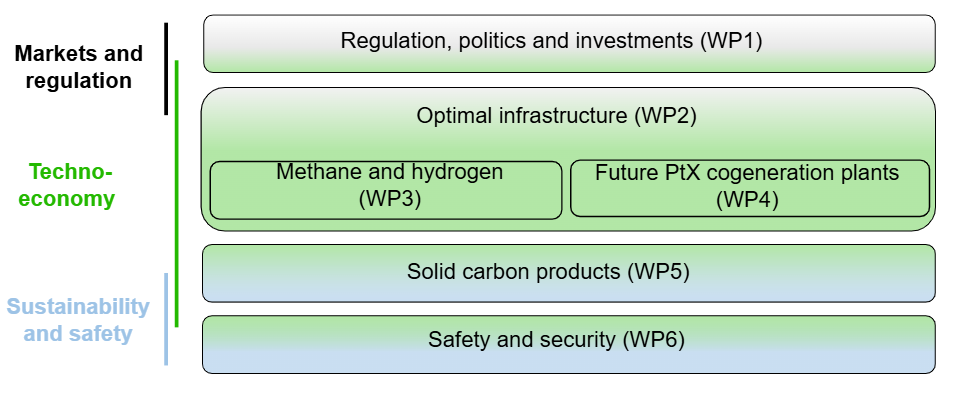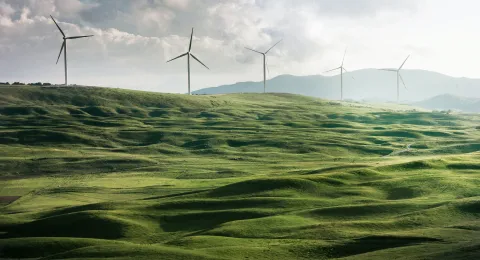
A constantly growing number of countries have adopted hydrogen strategies and are in the process of designing regulatory frameworks aligned with their policy choices to support the penetration of various forms of hydrogen and various products based on hydrogen. Raw material availability (electricity, hydrogen, and carbon dioxide) creates new location based competitive advantages in production.
The research in the WP1 was originally divided into the following tasks and objectives:
- Task 1.1 - Regulation of raw materials and end products. The goal of the task was to understand how countries leading the hydrogen uptake have designed their policies and what regulatory choices they have made in support of the implementation of these policies. The task also examined what type of regulatory framework can ensure that national interests in PtX can be realized when considering the regulatory choices in leading countries in this area.
- Task 1.2 - Geopolitical scenarios and investor opportunities. This task examined what types of national visions for the mid/long-term development of PtX policies and regulations exist in the case study countries and what types of national interests drive the identified visions. The task also examined how will the emerging geopolitics of PtX shape the choices of Finnish business actors.
- Task 1.3a - Hydrogen investment acceptance. This task explored the acceptance of hydrogen investments from both the investor viewpoint and from the viewpoint of the social acceptance of investments from general public.
- Task 1.3b - Value chain economics of chosen products. In this task the researchers created a value chain model to support investment decision making from the economics perspective.
To read about the results of this WP and its separate tasks, check the results.
Variable renewable electricity is the main primary energy source in the production of carbon-neutral products. Variable renewable electricity is available on a large scale almost unlimitedly. In addition, also other feed materials, such as CO2 and N2 are needed to manufacture carbon neutral end products, such as methanol and ammonia. However, there will be regional differences in the availability of these resources, and therefore, there is a need to analyze the generation potential and the competitiveness of producing different types of carbon neutral end products in different geographical locations.
The research in the WP2 was originally divided into the following tasks and objectives:
- Task 2.1 - Energy resources and their efficiencies. The main goal of the task was to identify the renewable energy and CO2 resources and the locations of these resources. Furthermore, the task identified the technical options for transporting these resources and their operational requirements and life-time costs.
- Task 2.2 - Optimal national and international infrastructures. The goal of the task was the development and application of a generic system model to study and define optimal value chains and values of carbon neutral end products in different market areas. The fundamental goal was to position the Finnish industry in the arising PtX products business for creating a value add and competitive edge.
- Task 2.3 - Scenarios for feasible infrastructures in Finland. This task studied which infrastructure elements are essential for the successful development of fossil carbon free value chains. The work was based on business scenarios defined together with other work groups while also considering the evolution of industrial processes and customer segments. Feasibilities of scenarios were analyzed by using mathematical model of the Finnish energy system divided in nine regions and representing power supply, demand and storage, energy transmission, and sector couplings between different grids (electricity, heat, hydrogen, CO2, etc.).
To read about the results of this WP and its separate tasks, check the results.
The goal was to study how methane-based infrastructure, and especially the gas network, could be used in the hydrogen-based energy system. Another goal was to study the role of biogas and biogenic/biological PtG gases and how those will utilize the network in future.
The research in the WP3 was originally divided into the following tasks and objectives:
- Task 3.1 - Hydrogen in the gas transmission network. This task examined how the natural gas transmission infrastructure in Finland and between Finland and the European market areas could be utilized in future. The task also examined if the current infrastructure will be available for transporting hydrogen and carbon dioxide, and what would be the role of it in the PtG and PtX energy economy.
- Task 3.2 - Material aspects in hydrogen and methane-infrastructure. This task examined what are the critical material aspects in the hydrogen-based infrastructure, and what are the critical material aspects in the methane-based infrastructure when planning to convert methane-based infrastructure (pipelines, LNG, CNG, and components) to hydrogen.
- Task 3.3 - Industrial applicability of biogenic PtG. Microbiological processes, such as anaerobic digestion and ethanol production produce relatively clean CO2 streams. Combining hydrogen to these streams would allow producing biomethane (PtG). There are three approaches to biological methanation:1) In situ feeding of H2 to biogas reactor to increase methane production, 2) Upgrading (raw) biogas using biological methanation and 3) biological methanation of biogenic CO2 .This task studied the potential and maturity of these processes for PtG.
To read about the results of this WP and its separate tasks, check the results.
The goal was to model a single PtX plant at different levels (electrolysis, CO2 capture models, synthesis processes, heat and process integration, water treatment), and the integration to surrounding operation environment.
The research in the WP4 was originally divided into the following tasks and objectives.
- Task 4.1 - Dynamic modelling of synthesis processes. The goal was to find out how to design and operate dynamic synthesis processes while considering variable electricity production (Aspen dynamic simulation). The material and energy efficiencies of different PtX production routes, including unit operations, were studied. The research also concentrated to the technological limits in dynamic operation of methanol and methane production processes.
- Task 4.2 - Plant-level design and flexibility. The goal was to determine the overall energetic and exergetic performances of producing hydrogen, CO2, methanol, methane and ammonia and find out, how efficiently optimize PtX cogeneration plant integration and operation. Also, the objective was to discover, how the flexibility, cost assumptions, and integration environment affect the overall techno-economic performance and optimal unit capacities.
- Task 4.3 - Advanced data-driven methods in Power-to-X operations . The goal was to develop a general framework for developing a cyber-physical management of cogeneration plant production based on data processing for AI with IoT. The best class of learning methods considering the specific needs and constraints imposed by the cogeneration plant production were studied. Furthermore, the goal was to find out how to either adapt existing or develop new learning techniques to automatize selected processes for the plant operation. The research also concentrated to discover, what are the best suited computer architectures for industrial IoT based on the requirements of PtX cogeneration plant.
To read about the results of this WP and its separate tasks, check the results.
The goal was to study electrochemical reduction of CO2 with molten salt electrolysis to solid carbon products, e.g. nanotubes.
The research in the WP5 was originally divided into the following tasks and objectives:
- Task 5.1 - Solid carbon products and markets. Existing and future markets of solid carbon products were studied including the product quality requirements.
- Task 5.2 - Energy efficient CO2 electrolysis. The energy efficiency of molten salt electrolysis was improved by studying the effect of electrode materials, electrolyte composition, electrolyzer structure and process conditions.
- Task 5.3 - Industrial scale CO2 electrolysis. Reactor designs suitable for industrial scale with possibly continuous process were studied with experiments and simulation. Techno-economic feasibility of molten salt electrolysis was analyzed.
To read about the results of this WP and its separate tasks, check the results.
The work package focused on research covering a whole life cycle of product chains as well as system-level studies. The focus wasn't only on identifying risks but also positive impacts of the product chains were examined.
The research in the WP6 was originally divided into the following tasks and objectives:
- Task 6.1 - Possibilities and risks arising from climate issues. In this task, environmental sustainability was evaluated to find the possibilities and risks the solution offers. System-level assessments are needed to show how environmental impacts change in a system level when new product chains are integrated to existing systems. It is important to examine, if emissions increase or decrease in a case where investments enabling PtX product-chains are added to an existing system. Product-level studies are also needed to show if a product produced is compliant with legislation and how a product-chain results in environmental impacts in different stages of a life cycle.
- Task 6.2 - Regulatory and financial risks threatening business. In this task, risks related to legislation and finance were evaluated. This was done in collaboration with WP 1. For instance, legislation may chance regarding sustainable ways to produce end-products (e.g, the source of CO2 or electricity). Acceptable ways to use land may also change as well as the sustainability criteria related to green investments. Permission procedure may take too long time and increase uncertainty. Enlarging carbon price schemes as well as higher carbon prices may increase interest towards low-emitting solutions. In case carbon price is too low, it may hinder investments to the needed infrastructure.
- Task 6.3 - Operational risks and cybersecurity. The aim of this task was to recognize the hazards and risks in PtX value chains. Another objective was to recognize the hazards and risks arising from connected networks and used information systems. Thirdly, it is important to identify the risk management measures that need to be taken to avoid person, environment or property damage.
To read about the results of this WP and its separate tasks, check the results.
